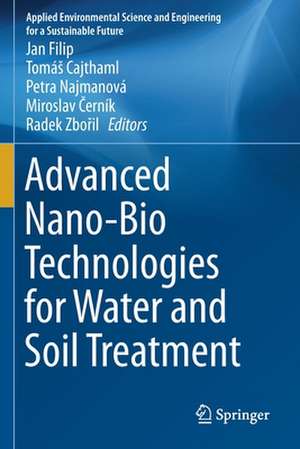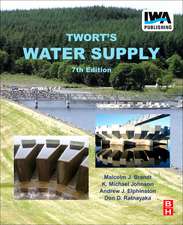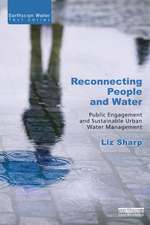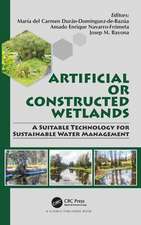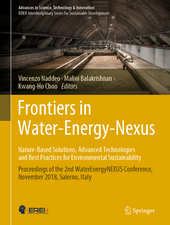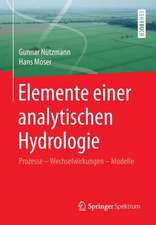Advanced Nano-Bio Technologies for Water and Soil Treatment: Applied Environmental Science and Engineering for a Sustainable Future
Editat de Jan Filip, Tomáš Cajthaml, Petra Najmanová, Miroslav Černík, Radek Zbořilen Limba Engleză Paperback – 26 aug 2021
Nowadays, a broad range of contaminants are emerging from the industry (and also representing old ecological burdens). Accidents and improper wastewater treatment requires a fast, efficient and cost-effective approach. Therefore, several innovative technologies of water and soil treatments have been invented and suggested in a number of published papers.
Out of these, some nanotechnologies and biotechnologies (and possibly also their mutual combinations) turned out to be promising for practical utilization – i.e., based on both extensive laboratory testing and pilot-scale verification.
With respect to the diverse character of targeted pollutants, the key technologies covered in this book will include oxidation, reduction, sorption and/or biological degradation. In relation to innovative technologies and new emerging pollutants mentioned in this proposed book, an important part will also cover the ecotoxicity of selected pollutants and novel nanomaterials used for remediation.
Thus, this work will consist of 8 sections/chapters with a technical appendix as an important part of the book, where some technical details and standardized protocols will be clearly presented for their possible implementation at different contaminated sites. Although many previously published papers and books (or book chapters) are devoted to some aspects of nano-/biotechnologies, here we will bring a first complete and comprehensive treatise on the latest progress in innovative technologies with a clear demonstration of the applicability of particular methods based on results of the authors from pilot tests (i.e., based on the data collected within several applied projects, mainly national project “Environmentally friendly nanotechnologies and biotechnologies in water and soil treatment” of the Technology Agency of the Czech Republic, and 7FP project NANOREM: “Taking Nanotechnological Remediation Processes from Lab Scale to End User Applications for the Restoration of a Clean Environment”).
This multidisciplinary book will be suitable for a broad audience including environmental scientists, practitioners, policymakers and toxicologists (and of course graduate students of diverse fields – material science, chemistry, biology, geology, hydrogeology, engineering etc.).
| Toate formatele și edițiile | Preț | Express |
|---|---|---|
| Paperback (1) | 1126.17 lei 6-8 săpt. | |
| Springer International Publishing – 26 aug 2021 | 1126.17 lei 6-8 săpt. | |
| Hardback (1) | 935.52 lei 38-44 zile | |
| Springer International Publishing – 18 ian 2020 | 935.52 lei 38-44 zile |
Din seria Applied Environmental Science and Engineering for a Sustainable Future
- 18%
 Preț: 727.00 lei
Preț: 727.00 lei - 15%
 Preț: 645.28 lei
Preț: 645.28 lei - 15%
 Preț: 653.14 lei
Preț: 653.14 lei - 18%
 Preț: 892.90 lei
Preț: 892.90 lei - 18%
 Preț: 951.47 lei
Preț: 951.47 lei - 18%
 Preț: 1003.38 lei
Preț: 1003.38 lei - 15%
 Preț: 639.73 lei
Preț: 639.73 lei - 20%
 Preț: 576.05 lei
Preț: 576.05 lei - 19%
 Preț: 596.62 lei
Preț: 596.62 lei - 18%
 Preț: 1388.05 lei
Preț: 1388.05 lei - 24%
 Preț: 935.52 lei
Preț: 935.52 lei - 15%
 Preț: 641.71 lei
Preț: 641.71 lei - 15%
 Preț: 644.30 lei
Preț: 644.30 lei - 18%
 Preț: 1113.89 lei
Preț: 1113.89 lei - 18%
 Preț: 725.61 lei
Preț: 725.61 lei - 18%
 Preț: 895.27 lei
Preț: 895.27 lei
Preț: 1126.17 lei
Preț vechi: 1373.38 lei
-18% Nou
Puncte Express: 1689
Preț estimativ în valută:
215.49€ • 225.59$ • 178.31£
215.49€ • 225.59$ • 178.31£
Carte tipărită la comandă
Livrare economică 05-19 aprilie
Preluare comenzi: 021 569.72.76
Specificații
ISBN-13: 9783030298425
ISBN-10: 3030298426
Ilustrații: XXV, 657 p. 210 illus., 133 illus. in color.
Dimensiuni: 155 x 235 mm
Greutate: 0.94 kg
Ediția:1st ed. 2020
Editura: Springer International Publishing
Colecția Springer
Seria Applied Environmental Science and Engineering for a Sustainable Future
Locul publicării:Cham, Switzerland
ISBN-10: 3030298426
Ilustrații: XXV, 657 p. 210 illus., 133 illus. in color.
Dimensiuni: 155 x 235 mm
Greutate: 0.94 kg
Ediția:1st ed. 2020
Editura: Springer International Publishing
Colecția Springer
Seria Applied Environmental Science and Engineering for a Sustainable Future
Locul publicării:Cham, Switzerland
Cuprins
Preface.- Part I Reductive Technologies.- Geochemical Principles of Reductive Remediation Processes.- Nanoscale Zero-Valent Iron Particles for Water Treatment: from Basic Principles to Field-Scale Applications.- Other Chemical Reductive Methods.- Combination of Electrokinetics and nZVI Remediation.- Field Study I: In Situ Chemical Reduction Using Nanoscale Zero-valent Iron Materials to Degrade Chlorinated Hydrocarbons.- Field Study II: Pilot Application of nZVI/DC-combined Methods at Aargau Site.- Part II Oxidative Technologies.- Introduction to Oxidative Technologies for Water Treatment.- Ferrates as Powerful Oxidants in Water Treatment Technologies.- Radical Reactions and Their Application for Water Treatment.- Photo-oxidation Technologies for Advanced Water Treatment.- The Use of Nanomaterials in Electro-Fenton and Photoelectro-Fenton Processes.- Field Study III: Evidence Gained from Site Studies for the Performance of Ferrate(VI) in Water and Wastewater Treatment.- Field Study IV: Arsenic Removal from Groundwater by Ferrate with the Concurrent Disinfecting Effect—Semi-pilot on-site Application.- Field Study V: Combined Oxidation Technology using Ferrates (FeIV–VI) and Hydrogen Peroxide for Rapid and Effective Remediation of Contaminated Water—Comprehensive Practically Focused Study.- Part III Biotechnologies for Water Treatment.- Biotechnologies for Water Treatment.- Enzyme-Based Nanomaterials in Bioremediation.- Bioelectrochemical Processes for the Treatment of Oil-Contaminated Water and Sediments.- Field Study VI: The Effect of Loading Strategies on Removal Efficiencies of a Hybrid Constructed Wetland Treating mixed Domestic and Agro-Industrial Wastewaters.- Field Study VII: Field Study of Three Different Injectable Oxygen Sources to Enhance Mono-Aromatic Solvents in situ Biodegradation.- Field Study VIII: Nano-bioremediation: nZVI for Inorganic and Organic Contamination.- Part IV Biotechnologies for Soil Treatment.- Biotechnologies for Soil Treatment.- Mycoremediation of Contaminated Soils.- Composting Practices for the Remediation of Matrices Contaminated by Recalcitrant Organic Pollutants.- Modern Bioremediation Approaches: Use of Biosurfactants, Emulsifiers, Enzymes, Biopesticides, GMOs.- Field Study IX: Pilot-Scale Composting of PAH-Contaminated Materials—Two Different Approaches.- Field Study X: Oil Waste Processing Using Combination of Physical Pretreatment and Bioremediation.- Part V Ecotoxicology of Both Environmental Pollutants and Nanomaterials Used for Remediation.- Ecotoxicology of Environmental Pollutants.- Ecotoxicity of Nanomaterials Used for Remediation.- VI Future Prospects.- Future Prospects for Treating Contaminants of Emerging Concern in Water and Soils/Sediments.- Part VII Technical Chapters.-Tool I: Characterization of nZVI Mobility in 1D and Cascade Columns by Ferromagnetic Susceptibility Sensor.- Tool II: Membrane Interface Probe.- Tool III: Fracturing for Enhanced Delivery of In situ Remediation Substances in Contaminated Sediments.- Tool IV: Monitoring of nZVI Migration and Fate in the Groundwater Conditions.- Tool V: Microbiological Methods for Monitoring nZVI Performance in Groundwater Conditions.
Textul de pe ultima copertă
This edited work presents a comprehensive treatise on the latest progress in the field of selected innovative nanotechnologies, biotechnologies, and their possible combinations for efficient elimination of a broad range of pollutants from various types of water and soil. It covers the underlying principles of all the key technologies (reductive and oxidative technologies for water treatment and biotechnologies for water and soil treatment). Moreover, it includes toxicological evaluation of emerging pollutants and novel engineered nanoparticles, as well as providing results of field-scale verification and application of the most promising technologies.
Central aspects covered in this book include: geochemistry of iron, properties of iron nanoparticles (nZVI) and related materials for water treatment, in situ methods for groundwater treatment, evaluation of various combined nano/bio technologies, mechanisms and efficiencies of degradation/dechlorination of chlorinated hydrocarbons (aswell as other organic pollutants like POPs, PAHs, etc.), elimination of arsenic and Cr(VI) from water, advanced oxidation processes with a strong focus on high-valent states of iron (ferrates), radical reactions, photooxidation, Fenton reactions, disinfection, and biodegradation including mycoremediation and composting of a wide range of pollutants from water and soil. In addition, technical details of selected strategies adopted for a pilot/full-scale application of key nano-/biotechnologies, i.e. nZVI injection into groundwater, field-scale contaminant monitoring, nanoparticle migration, and microbiological methods for monitoring nZVI performance in groundwater conditions, are presented.
Therefore, this multidisciplinary book will be suitable for a broad readership including environmental scientists, practitioners, policymakers, toxicologists, and, of course, students of diverse fields such as materials science, chemistry, biology, geology, hydrogeology, engineering, etc.
Therefore, this multidisciplinary book will be suitable for a broad readership including environmental scientists, practitioners, policymakers, toxicologists, and, of course, students of diverse fields such as materials science, chemistry, biology, geology, hydrogeology, engineering, etc.
Caracteristici
A profound insight into modern nano-, bio-, and combined technologies for water and soil remediation Addressing toxicity of emerging pollutants and nanoparticles along with evaluating their impact on the environment Demonstration of decontamination techniques in the remediated sites through field studies including technical description
